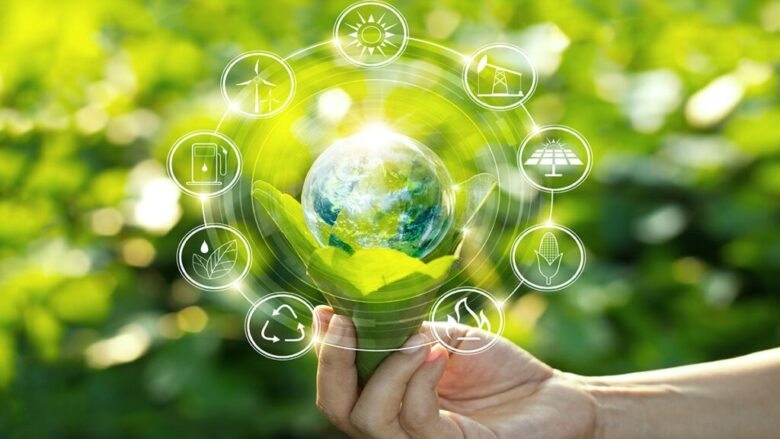As environmental concerns grow, green technology solutions are becoming increasingly important as a way to mitigate climate change, reduce carbon emissions, and support long-term growth. These technologies use resources that can be used over and over again, have a low impact on the environment, and offer a great alternative to the old way of doing things. This article discusses the importance of green technology options, how they can be used in many different ways, and how they can help make the future more sustainable.
Understand Green Technology
Green technology, also called clean technology or environmental technology, includes many new ideas designed to help the environment while meeting people’s needs. The goals of these technologies are to protect natural resources, reduce pollution, stimulate the energy economy, and support environmentally friendly practices in many areas.
Important Green Technical Solutions
1. Sources of renewable energy
Solar energy: Solar energy uses photovoltaic cells and solar thermal systems to convert sunlight into energy.
Wind energy: Wind energy is the use of wind turbines to convert wind energy into electricity that can be used by homes, businesses, and factories.
Hydropower: Hydropower is the process of using water flowing through rivers, dams, and tidal systems to generate electricity.
Geothermal energy: Geothermal energy is the process of harvesting heat from beneath the Earth’s surface to power homes and businesses.
2. Energy-saving technology
Smart grids: Smart grids make it easier to distribute energy and add green energy to the electricity grid.
Energy-efficient buildings: Energy-efficient buildings are those designed with better insulation, appliances that use less energy, and passive heating and cooling systems.
LED lighting: Use light-emitting diodes (LEDs) to create lighting that works well and lasts a long time.
3. Environmentally friendly transportation
Electric vehicles: Electric vehicles (EVs) are cars that run on electricity instead of gasoline or diesel, and emit fewer greenhouse gases.
Public transportation: Encourage efficient modes of public transportation to reduce personal car use and traffic congestion.
Shared transportation: Promoting shared transportation options such as carpooling and carpooling can help make the most of transportation resources.
4. Waste treatment and recycling technology
Advanced recycling technologies: New recycling methods can extract materials from waste and reduce the amount of waste ending up in landfills.
Biodegradable materials: Create plastics and packaging materials that are more environmentally friendly than what we use today.
Composting Systems: Compost systems use organic waste to create nutrient-rich soil that can be used in horticulture and agriculture.
Benefits of Green Technology Solutions
Environmental Protection: To protect ecosystems and wildlife, we need to reduce CO2 emissions, safeguard natural resources, and reduce pollution as much as possible.
Energy independence: Energy independence means reducing the use of fossil fuels and ensuring sufficient energy through the use of green energy.
Economic growth: Economic growth means creating jobs, encouraging new ideas, and getting people to invest in cleaning products and environmentally friendly ways of doing things.
Improving public health: Improving public health means reducing air and water pollution, limiting health risks from climate change, and encouraging improvements to the living environment.
Problems with the Use of Green Technology
Costs to consider: Green technologies may cost more to adopt than standard technologies, but they often save a lot of money in the long run because they use less energy and resources.
Technology limitations: Some green technologies, such as renewables, may have intermittent issues, such as solar and wind energy that are constantly changing. These technologies require better network integration and storage solutions.
Policy and regulatory framework: Inconsistent policies, lack of incentives, and regulatory barriers can make it difficult for green technologies to be widely used and deployed.
Role of Green Technology in a Sustainable Future
Global sustainability goals such as the United Nations Sustainable Development Goals (SDGs) and the commitments made under the Paris Agreement can be significantly advanced through the use of environmentally friendly technological solutions. Green technologies help minimize the impacts of climate change and build resilient, low-carbon communities. These technologies achieve this by accelerating the deployment of renewable energy, improving energy efficiency, supporting sustainable transportation, and improving waste management practices.
Conclusion
Implementing environmentally friendly technology solutions is critical to solving environmental problems and promoting sustainable growth across all sectors. By using renewable energy, improving energy efficiency, adopting sustainable transportation alternatives, and implementing advanced waste management methods, society can reduce its environmental footprint and move towards a more sustainable future. Continued innovation, investment, and collaboration are key components in advancing environmentally friendly technologies and delivering on the promise of a cleaner, healthier planet for future generations.
FAQs
1. What does ‘green technology’ mean?
The term “green technology”, often called “clean technology” or “environmental technology”, describes techniques and technologies designed to conserve natural resources, absorb human impact on the environment, and encourage sustainable development. Implementing these technologies can help reduce the impacts of climate change and improve environmental quality.
2. What are some examples of environmentally friendly practices?
Examples of green technology solutions include renewable energy (such as solar, wind, hydropower, and geothermal energy), energy-saving technologies (such as smart grids and LED lighting), sustainable transport (including electric vehicles and public transport), and advanced waste management. Management and recycling technology. These are just a few examples.
3. How exactly do eco-friendly technology solutions help the environment?
Reducing greenhouse gas emissions, protecting natural resources (such as water and forests), reducing pollution (air, water, and soil), and promoting biodiversity conservation are all ways in which green technology solutions can improve human health. Environment. They contribute to the fight against climate change and the protection of ecosystems.
4. What are the financial benefits of environmentally friendly technologies?
Green technologies help drive economic growth by creating jobs in areas such as energy efficiency, renewable energy, and sustainable businesses. This not only encourages investment in environmentally friendly technologies but also reduces overall energy costs over time, improves energy security, and stimulates innovation and technological development.
5. What barriers need to be overcome to adopt environmentally friendly technological solutions?
High initial costs of implementation and infrastructure development, technological limitations (such as the intermittent availability of renewable energy), regulatory barriers, and the need for supportive policies and incentives to promote widespread adoption are some of the challenges that must be overcome to successfully adopt environmentally friendly technologies. Friendly technological solutions.
6. In what ways can individuals do their part to advance environmentally friendly technology solutions?
Individuals can do this by implementing energy-efficient practices in homes and transportation, supporting renewable energy production initiatives (such as rooftop solar installations), reducing waste and promoting recycling, advocating for sustainable policies, and raising awareness about the benefits of green technologies.



